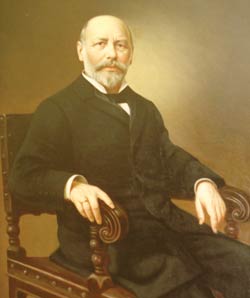Moriz Kaposi and the golden age of Viennese dermatology
Kaposi studied diseases such as rhinoscleroma and erythema multiforme in the late 1800s.
Moriz Kaposi is best known for his discovery of what would become a main characteristic of AIDS — Kaposi’s sarcoma; but his contributions to medicine encompass many fields of study, including dermatology and infectious diseases. Kaposi was born Moriz Kohn on Oct. 23, 1837 in Kaposvár, Hungary.
Though he grew up in a poor household, Kaposi was rich in support from his family. After finishing elementary and some secondary school in his native land, Kaposi completed his studies in Bratislava between 1853 and 1856. He then attended Vienna University of Medicine in Austria where he became a doctor of medicine in 1861. The following year he graduated as a doctor of surgery and in 1866 as a master of obstetrics.
For two years, Kaposi worked in the department of syphilology, where he was later appointed associate professor. In 1866, Kaposi joined the department of Ferdinand Ritter von Hebra, a renowned Austrian dermatologist.
|
Source: Archive University of Vienna, shelfmark: 105.P137. |
During his time with Hebra, Kaposi broadened his knowledge of dermatology. He researched the etiology and histology of diseases like rhinoscleroma, erythema multiforme and the fungi-causing mycoses.
In 1869, Kaposi converted from Judaism to Roman Catholicism to marry Hebra’s daughter, Martha. Two years later, he changed his name to create distinction between him and other physicians named Kohn; he chose Kaposi after the Kapos River, paying homage to his birthplace.
Invaluable contributions
In 1872, Kaposi described what would later become an extremely common and well-known tumor type, Kaposi’s sarcoma. He documented the sarcoma in a report titled, Idiopathic multiple pigmented sarcoma of the skin. The lesions were found on the feet and hands of five patients.
Kaposi recorded hemorrhages on histopathological exam and proposed the use of the word “hemorrhagicum,” as opposed to “pigmentosum,” to avoid confusion with melanoma.
Though Kaposi believed the disorder to be systemic, possible causes for the disorder included infectious hyperplasia, systemic vascular disease and neurovascular disease. The sarcoma was frequently found in patients being administered immunosuppressive drugs.
Kaposi became a full professor in Hebra’s department in 1875, during which time he contributed more than 100 publications to the field of dermatology. In 1880, he published the “Textbook of Skin Diseases,” which later gained fame in the dermatologic world and was reprinted in various languages.
After Hebra’s death, Kaposi assumed the position of chairman of the department of dermatology, and competed with brother-in-law Hans von Hebra for his father-in-law’s position. On Feb. 8, 1881, Kaposi’s appointment was announced, and he commemorated his father-in-law during his inaugural lecture that year.
Kaposi continued to make invaluable contributions to the field of dermatology when he reported on the first cases of xeroderma pigmentosum in 1882. He documented skin alterations in infants and young children that led to the development of neoplasms throughout life and, subsequently, to death.
Later years
Kaposi served as a vice president of the International Congress of Dermatology in 1889, a host and president in 1892 and a foreign secretary in 1896. In 1900, he served alongside Jonathan Hutchinson as an honorary president of the congress.
He served in many organizations and held numerous titles in several countries. He was a member of the Imperial Order of Emperor Leopold; was appointed one of the highest academic titles in Austria, Imperial Counselor; was officer of the Legion d’Honneur of France; and was a corresponding member of the Académie de Médicine de Paris.
Kaposi was fluent in German, French and English, as well as his native Hungarian. He was an eloquent and sought-after speaker, though his colleagues were cautious of his astute criticism.
Near the end of 1900, Kaposi suffered a stroke. He recovered, but soon suffered a second, more serious stroke. He survived for two years, continuing to lecture and carry out duties at the hospital; he died on March 6, 1902.
Famous eponym
Since its introduction in 1872, Kaposi’s sarcoma has become a well-known neoplasm. Currently, there are four clinical subtypes: classic; endemic (African); associated with transplantation or immunosuppressive therapy; and epidemic (HIV/AIDS associated).
Nodules and plaques are characteristic of classic Kaposi’s sarcoma, and they affect the hands and feet, occasionally progressing to the arms and legs. Pressure on underlying structures may cause pain at the site of skin lesions, but other lesions may be asymptomatic. Typically, the sarcoma is slow to progress, and some cases of lesion regression have been reported.
Endemic Kaposi’s sarcoma occurs most often in young children in sub-Saharan Africa. Though histopathologies are similar between endemic and classic, endemic Kaposi’s sarcoma can include lymph node involvement and has a poor outlook in children.
Kaposi’s sarcoma became a classic characteristic of AIDS in the 1980s and was one of the first-reported clinical manifestations of HIV. Due to its large occurrence in sex-related AIDS, Kaposi’s sarcoma was once thought to be a sexually transmitted infectious disease.
Though there is no universally effective treatment for Kaposi’s sarcoma, often HIV-associated Kaposi’s sarcoma responds to highly active antiretroviral therapy. Since the introduction of highly active antiretroviral therapy, the number of cases of epidemic Kaposi’s sarcoma has declined. – by Stacey L. Adams
For more information:
- Lancet. 2004;364:1549-1552.
- Med Pediatr Oncol. 1996;27:128-131.
- CA Cancer J Clin. 1982;32:340-341.
- Anais Brasileiros de Dermatologia. 2005;80:197-198.
- J R Soc Med. 1986;79:532-534.

